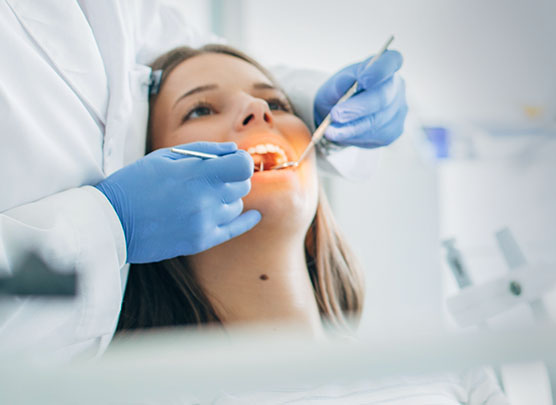Stop problems before they start. Preventive dentistry is your best defense against tooth decay, infection and other dental problems. We help keep your teeth healthy and your smile bright.

Why is preventive dentistry important?
Your teeth are covered with a sticky film called plaque that can contribute to tooth decay and gum disease. Plaque contains bacteria, which following a meal or snack can release acids that attack tooth enamel. Repeated attacks can cause the enamel to break down, eventually resulting in cavities. Plaque that is not removed with thorough daily brushing and cleaning between teeth can eventually harden into calculus or tartar. This makes it more difficult to keep your teeth clean.When tartar collects above the gum line, the gum tissue can become swollen and may bleed easily. This is called gingivitis, the early stage of gum disease.
You can prevent plaque buildup and keep your teeth and gums healthy and cavity-free by regularly visiting the dentist, brushing twice a day with a fluoride toothpaste and cleaning between your teeth with dental floss daily.
Preventing tooth decay, gum disease, and early detection of dental health problems is vital to ensuring your good dental and overall health. Regular professional cleanings ensure that your teeth are free from cavity-causing bacterial buildup so cavities can’t form. And regular dental examinations let us detect, diagnose, and treat problems early before they become serious and more difficult to treat.
Oral hygiene
Professional cleaning is the best way to remove plaque and calculus from your teeth. We use special tools to remove tartar from the hard-to-reach areas of your teeth, and we can also recommend preventive treatments, such as fluoride treatments, to help prevent cavities.
Dental examination
A thorough examination will detect early signs of tooth decay, infection and disease, and other dental health issues. A typical dental exam includes a physical examination of your teeth, mouth, and jaw. It may also include x-rays and other diagnostic tests.
Oral cancer screening
Oral cancer is a potentially deadly cancer that affects thousands of people each year. During your preventative dentistry appointment, we will screen for early signs of oral cancer. Early detection increases the chances of successful treatment.
Brushing your teeth
Brushing your teeth is an important part of your dental care routine. For a healthy mouth and smile:
- Brush your teeth twice a day with a soft-bristled brush. The size and shape of your brush should fit your mouth allowing you to reach all areas easily.
- Replace your toothbrush every three or four months, or sooner if the bristles are frayed. A worn toothbrush won’t do a good job of cleaning your teeth.
- Make sure to use a fluoride toothpaste.
The proper brushing technique is to:
- Place your toothbrush at a 45-degree angle to the gums.
- Gently move the brush back and forth in short (tooth-wide) strokes.
- Brush the outer surfaces, the inner surfaces, and the chewing surfaces of the teeth.
- To clean the inside surfaces of the front teeth, tilt the brush vertically and make several up-and-down strokes.
Flossing
Brushing two times daily for at least two minutes each time is the first step in keeping your teeth and gums healthy. But even the best toothbrush can’t fully cleanse the spaces between your teeth. That’s why we recommend that you floss at least once a day to remove food particles and plaque – the sticky film on your teeth that can lead to cavities and gum disease.
Plaque contains cavity-causing bacteria that feed on leftover food in your mouth. These bacteria love sugary substances — and as they feast on them, they produce acids that can harm the shiny, protective surface of your teeth, setting the stage for tooth decay.
Plaque that isn’t cleansed away by brushing or flossing can harden into a rough substance called tartar or calculus. Tartar builds up along your gum line, which can lead to gum disease. Once tartar forms, only your dentist can remove it, but flossing every day can prevent plaque and tartar buildup.
5 steps for flawless flossing
Ever wondered if you’re using dental floss the right way? Here are a few tips to make flossing easier.
- Break off about 18 inches of floss, wrapping most of it around one of your middle fingers. Wind the remaining floss around the same finger of the opposite hand. This finger will take up the floss as you move along.
- Hold the floss tightly between your thumbs and forefingers.
- Guide the floss between your teeth using a gentle, rubbing motion. Never snap the floss into the gums.
- When the floss reaches the gum line, curve it into a C shape against one tooth. Gently slide it into the space between the gum and the tooth.
- Hold the floss tightly against the tooth, slightly away from the gums. Gently rub the side of the tooth with an up-and-down motion, following the shape of the tooth. Repeat this method on the rest of your teeth, top and bottom. Don’t forget the back side of your last teeth (at the very back of your mouth.)
Frequently asked questions
How often should I go for a cleaning?
Your teeth and mouth are as unique as you are. We will recommend that your teeth be cleaned and examined in our office based on your individual needs and concerns, to help you prevent decay and to detect problems before they become serious. Some patients may need to come for more frequent cleanings and examinations, depending on their needs.
Are fluoride treatments safe?
Yes. Fluoride treatment is a highly effective way to strengthen teeth and protect them from cavities.
What should I use to clean between my teeth?
Fortunately, there are many safe, and effective tools made for the job. You can choose from traditional dental floss — a smooth strand of nylon or teflon made to slide easily between teeth — as well as dental picks, tiny brushes or water flossers.
We will help you find the flossing tool that is right for you. Many people find that classic string floss works well. Dental picks and tiny brushes can be good for reaching out-of-the-way spots. There are pre-threaded flossers that come fitted with picks or brushes at one end, giving you a couple of different ways to get between teeth.
A water flosser, which uses a gentle stream of water to rinse away food and plaque, can be useful if you find other tools hard to work with. People with braces, bridges and other dental work may find that a water flosser helps them reach every nook and cranny.
Should I floss before or after brushing my teeth?
As long as you floss thoroughly, it doesn’t matter when you do it. The most important thing is to make flossing a daily habit. Choose a time of day when you can give your teeth a little extra attention. If you’re too tired at night, try flossing in the morning or after lunch.
Is flossing painful?
Keep in mind that cleaning between your teeth shouldn’t cause pain. If you floss too hard, you might damage the tissue between your teeth. If cleaning between your teeth hurts, talk with us to help you find the cause and solution.
Do children need to floss?
Yes. Flossing should become part of your child’s dental care routine as soon as they have two teeth that touch.


